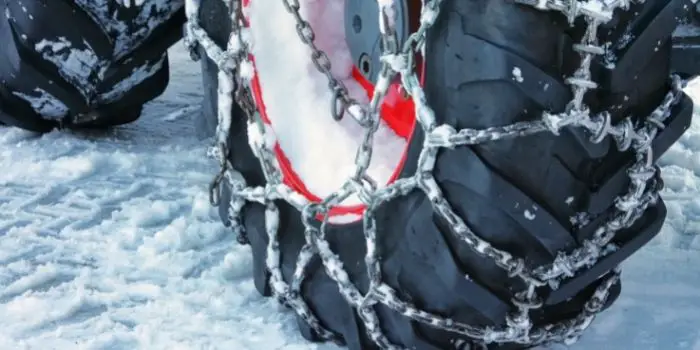Ever wondered how those big rigs navigate through snow and icy conditions? The answer is simple – they use snow chains!
Snow chains (also called tire chains) are a vital tool for any trucker driving in winter weather conditions.
And that’s the reason chains that go on the tires of a heavy truck to help it grip the road in snowy weather are a common sight during the winter.
But are these chains safe to use? And if so, how do you use them?
Let’s answer these questions and more in this post.
Table of Contents
Snow Chains
A tire chain is a device that helps improve traction on snow and ice-covered roads. It’s made up of two metal loops that are connected to the wheels of a vehicle.
The chains work by helping increase the contact area between the tires and the ground, providing more grip, traction, and stability.
This is especially important for trucks operating in winter weather conditions because they are much heavier than cars, making it more difficult for them to stop and start in slippery conditions.
There are two main types of tire chains:
- Cross-chain: This type of chain is designed to go across the tire tread. It provides more traction than a standard chain and is best used in deep snow or on icy roads.
- Ladder chain: This type of chain is designed to go around the tire tread. It is best used on packed snow or icy roads.
Are Snow Chains Safe?
Tire chains are safe when used properly. However, there are some risks associated with using them.
The biggest risk is that the chains can come off the tires while you’re driving which can be dangerous if the chain hits another vehicle or object.
To avoid this, follow the instructions carefully when installing and check the chains regularly to make sure they’re still secure.
Another risk is that the chains can damage the tires or the roads. This is more of a concern with cross-chains, which can wear down the tire treads. To avoid this, only use chains when necessary and drive slowly.
Remember that you should only use tire chains when driving in snow or ice. If the roads are dry, there’s no need to use them. In fact, using chains on dry roads can damage the tires and the roads.
Also, it’s good to be informed that there is no federal law in the United States requiring the use of tire chains, but some states and municipalities have their own laws.
For example, the state of California requires that all vehicles carry chains or other traction devices if they are traveling in certain mountainous areas.
So, it’s good to check the specific laws in your area before you install them and travel.
How to Put Snow Chains On a Truck?
While snow chains may seem like a hassle to put on, they are actually quite easy to install because most of them come with clear instructions on how to put them on.
Here’s a step-by-step guide to putting snow chains on a truck:
Step 1- Park the truck on a level surface and set the parking brake.
Step 2- Place blocks behind the rear wheels to prevent the truck from rolling while you’re working.
Step 3- Locate the chains that go on the front tires. The chains will have two loops, one for each tire.
Step 4- Place the chain around the tire so that the loops are on opposite sides of the tire.
Step 5- Connect the two ends of the chain together.
Step 6- Repeat steps 3-5 for the rear tires.
Step 7- Once all four tires have chains, you can remove the blocks and start driving.
Sometimes putting chains on a heavy truck can be a bit more challenging than putting them on a car, but it’s still doable with some patience and practice.
Here are a few tips to keep in mind when using snow chains safely:
- Make sure the chains are the right size for your tires.
- Read the instructions that come with the chains carefully before installation.
- Practice putting the chains on before you need to use them in winter weather conditions.
- Always put the chains on the front tires of the truck first.
- Once the chains are in place, tighten them according to the instructions.
- Drive slowly and carefully until you reach your destination.
Remember, the chains are only meant to provide traction and they will not make the truck stop any faster.
You can drive with them for as long as you need. However, it is important to keep in mind that driving with chains can be hard on the tires.
So remove them as soon as possible once you reach your destination or when you get back on the paved roads.
Are Snow Chains and Snow Tires the Same?
No, they are not the same. Chains are only meant for providing traction on icy or snowy roads, while snow tires are meant for providing traction as well as stability in snowy or icy conditions.
There is no easy answer when it comes to choosing between snow chains and snow tires. It really depends on your needs and preferences.
If you live in an area that gets a lot of snow, then snow tires may be the better option because they will provide traction and stability in all winter conditions.
However, if you only occasionally need extra traction, then snow chains may be the better option because they are easier to install and remove.
Ultimately, the decision is up to you and what you feel will work best for your needs.
Snow Chain Alternatives You Can Use On Your Truck
If you don’t have chains, use sand, kitty litter, or a tow strap. They will help provide some traction, but it’s not as effective as chains.
A few other alternative traction device options also include:
- AutoSock: These are textile sleeves that go over the drive wheels and offer an alternative to chains.
- Traction mats: These are placed under the drive wheels to provide traction.
- Tire socks: These are textile sleeves that go over the drive wheels and offer an alternative to chains.
- Tire Boots & Wraps: These go over the entire tire and offer an alternative to chains.
- “Spider” Spikes: These are metal spikes that screw into the tire tread and can offer a great alternative solution to chains.
If you need to pull the truck through the snow, attach one end of the strap to the front of the truck and the other end to the back of another vehicle.
If that doesn’t work, try digging the truck out of the snow. This is a lot of work, and it’s not always successful, but it’s worth a try if you’re stuck in deep snow.

Based in Orem (Utah) John Paterson graduated from Utah Valley University and has begun writing in 2009. He has a large wealth of experience in writing articles related to cars, automotive repair, wheels, cleaning/maintenance, and much more. He has also written instructional articles in a similar niche for a few online publications as well. Currently, he works as a mechanic in his personal garage shop where he loves serving his countrymen from his heart.






